-

新人教版高中英语必修3Unit 3 Diverse Cultures-Listening &Speaking&Talking教学设计
1. In Picture 1 and Picture 2, where do you think they are from? How do you know?From their wearings, we can know they are from ethnic minority of China--- Miao and Dong.Picture 1, they are playing their traditional instrument lusheng in their traditional costumes.Picture 2. the girls are Miao because they wear their traditional costumes and silver accessory.2. In Picture 3, can you find which village it is? What time is it in the picture?It is Dong village. It is at night. Step 2 While-listeningJustin met a new friend while traveling in Guizhou. Listen to their conversation and complete the summaries below.Part 1Justin and Wu Yue watched some Miao people play the lusheng. The instrument has a history of over 3,000 years and it is even mentioned in the oldest collection of Chinese poetry. Then they watched the lusheng dance. Justin wanted to buy some hand-made silver/traditional accessories as souvenirs. He was told that the price will depend on the percentage of silver. Part 2They will go to a pretty Dong minority village called Zhaoxing. they will see the drum towers and the wind and rain bridges. They may also see a performance of the Grand Song of the Dong people.Step 3 Post-listening---TalkingWork in groups. Imagine Justin is telling some friends about his trip to Guizhou. One of you is Justin and the rest of you are his friends. Ask Justin questions about his trip and experience. The following expressions may help you.
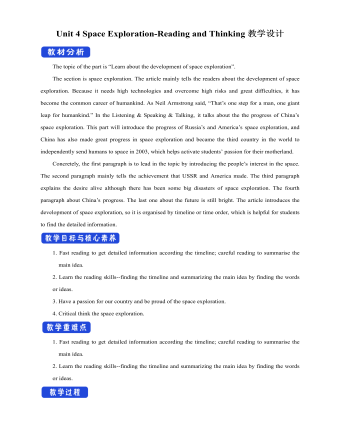
新人教版高中英语必修3Unit 4 Space Exploration-Reading and Thinking教学设计一
Q4: What is the function of the International exploration ?Having astronauts from different countries on boardQ5: What can you learn from Para 4 ?China has made great achievements in exploring spaceQ6: What is the attitude to the space exploration ?SupportiveStep 6 Post reading---RetellPeople have always wanted to learn more about space. Before the mid-20th century, most people felt (1)_________ (travel) into space was an impossible dream. However, (2)____ the help of scientists, peoplesucceeded in realizing their dream (3) _________ (explore) space. On 4 October 1957, the Sputnik 1 satellite (4) ____________(launch) by the USSR. (5) ________________ scientists try to make sure nothing goes wrong, accidents can still happen. These disasters made everyone(6)___________(disappoint), but people still believe in the importance of (7) ________(carry) on space exploration. In 2003, China became the third country to (8)_____________ (independent) send humans into space. Then Shenzhou 6 and 7 completed (9)____ second manned orbit and the first Chinese spacewalk. In spite of the difficulties, scientists hope future (10)__________ (discovery) will not only enable us to understand the universe but also help us survive well into the future.Answers: 1. travelling 2. with 3. to explore 4. was launched 5. Although6. disappointed 7. carrying 8. independently 9. a 10. discoveriesStep 6 Post reading---Critical thinkingQ1: What do you think of the space exploration ? I think it is beneficial to us. Through further study of space, people will make full use of it in the future, such as the space experiments by Wang Yaping in Tian Gong 1.Q2: If you are determined to be an astronaut, what should you prepare at present ?First of all, I should study hard to get a related college degree. Besides, I must keep mental and physical healthy.Step 7. HomeworkTry to summarize the structure of the article by a mind map.

新人教版高中英语必修3Unit 5 The Value of Money- Discovering Useful Structure教学设计
Step 3 Meaning1. 过去将来时表示从过去某一时间来看将要发生的动作或存在的状态, 常用在宾语从句中。一般由“would/should +动词原形”构成。She hoped that they would meet again someday. 她希望将来有一天他们能再见面。2. was/were going to+动词原形: 表示过去将要发生或很有可能发生的动作, 常用于口语中, 表示预言、意图或者打算等。He was going to start work the following week. 他打算下星期开始工作。3. was/were about to do: 常用来表示即将发生的动作, “刚要/正要做……”。注意该结构不与任何时间状语连用。I felt that something terrible was about to happen. 我感到某种可怕的事情即将发生。4.was/were to do: 表示“曾计划做某事”, 如果表示“本来计划做某事, 动作没实现”, 则需用 “was/were to have done”。She said she was to have told me about the accident. 她说她本来想告诉我关于事故的事。5.Start, go, come, leave, see, meet等动词的过去进行时: 表示就过去某一时刻而言即将发生的动作。She was coming later. 她随后就来。I had just put on my overcoat and was leaving to visit a friend of mine. 我刚穿上外套要去看我的一个朋友。
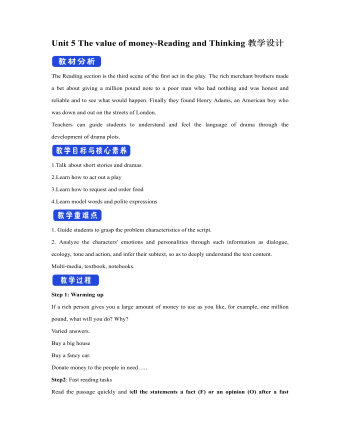
新人教版高中英语必修3Unit 5 The value of money-Reading and Thinking教学设计二
? Could you offer me some kind of work here?? I don’t want your charity, I just want an honest job.? Careless: I landed in Britain by accident.Step 7:Consolidation.? Find Henry? Roderick and Oliver were I .making a bet when they saw Henry, a poor young man. ? Know Henry? About a month ago, Henry was sailing and later he found himself carried out to sea by a strong wind. Fortunately, he 2.was spotted by a ship. And it was the ship that brought him to 3.England? Offer money to Henry ? Oliver and Roderick gave Henry a letter and told him that there was money in it. They 4.persuaded him to accept it, and made him 5.promise that it wouldn't be opened until 2 o'clock.Step 8:Language pointsa large amount of: a large quantity of; a great deal ofe.g. They bought a large amount of furniture before they moved their new house.make a bet: make an arrangement to risk money, etc. on an event of which the result is doubtful.e.g. We made a bet on the result of the match.permit sb to do something: allow somebody to do somethinge.g. My mother doesn’t permit me to ride in the street after it rained.by accident: as a result of chancee.g. I only found it by accident.stare at: look at somebody or something with the eyes wide open in a fixed gaze( in astonishment, wonder, fear, etc)to be honest: to tell you the truth; to be franke.g. To be honest, I don’t think we have a chance of winning.Step7 Homework:What do you think will happen to Henry? Will the bank-note help him or get him into trouble?

新人教版高中英语必修3Unit 5 the value of money-Reading For Writing教学设计一
【参考范文】Narrator:(Henry is smiling as he leaves the restaurant. As he is walking down the street, he sees a sign for a place that cuts hair. He decides to get it cut. )H=Henry;B=Barber;R=rude manH:Good afternoon, I'd like to get a cut, if I may. (The barber looks at Henry's hair and continues cutting another man's hair. )Er, I'd really like a haircut. As you can see it's much too long. B:(in a rude manner) Yes, I can see that. Indeed, I can. H:Fine, well I'll have a seat then. (He sits in one of the barber's chairs. The barber turns to look at Henry. )B:It's quite expensive here, you know!Are you sure you can afford it?H:Yes. I think so. (In comes the rude man. )R:Hey you there. I need a haircut quickly. Can you do me straightaway?B:All right, then, get in the chair and I'll see what I can do. R:Thank you. (sits down in one of the barber's chairs)H:Excuse me, but I was here first. Aren't you going to do my hair first?B:This man's in a hurry. H:Well so am I!I insist that you cut my hair first. B:OK, but I'll have to be quick. This gentleman is waiting. H:Thank you. (They both become quiet. After his hair is cut, the barber tells Henry how much he must pay. Henry shows the barber the bank note. )B:Why, Mr . . . (looks shocked)H:Adams. Henry Adams. I'm sorry, I don't have any change. R:You're that Mr Adams! Well,I'm glad I waited or I might never have known it was you. B:Why, Mr Adams, please don't worry!(wearing a big smile) Nothing to worry about!Nothing at all!Please come back any time, even if you only need too little hairs cut!It will be my honour to serve you!

新人教版高中英语选修2Unit 1 Science and Scientists-Discovering useful structures教学设计
The grammatical structure of this unit is predicative clause. Like object clause and subject clause, predicative clause is one of Nominal Clauses. The leading words of predicative clauses are that, what, how, what, where, as if, because, etc.The design of teaching activities aims to guide students to perceive the structural features of predicative clauses and think about their ideographic functions. Beyond that, students should be guided to use this grammar in the context apporpriately and flexibly.1. Enable the Ss to master the usage of the predicative clauses in this unit.2. Enable the Ss to use the predicative patterns flexibly.3. Train the Ss to apply some skills by doing the relevant exercises.1.Guide students to perceive the structural features of predicative clauses and think about their ideographic functions.2.Strengthen students' ability of using predicative clauses in context, but also cultivate their ability of text analysis and logical reasoning competence.Step1: Underline all the examples in the reading passage, where noun clauses are used as the predicative. Then state their meaning and functions.1) One theory was that bad air caused the disease.2) Another theory was that cholera was caused by an infection from germs in food or water.3) The truth was that the water from the Broad Street had been infected by waste.Sum up the rules of grammar:1. 以上黑体部分在句中作表语。2. 句1、2、3中的that在从句中不作成分,只起连接作用。 Step2: Review the basic components of predicative clauses1.Definition

新人教版高中英语选修2Unit 1 Science and Scientists-Learning about Language教学设计
Step 7: complete the discourse according to the grammar rules.Cholera used to be one of the most 1.__________ (fear) diseases in the world. In the early 19th century, _2_________ an outbreak of cholera hit Europe, millions of people died. But neither its cause, 3__________ its cure was understood. A British doctor, John Snow, wanted to solve the problem and he knew that cholera would not be controlled _4_________ its cause was found. In general, there were two contradictory theories 5 __________ explained how cholera spread. The first suggested that bad air caused the disease. The second was that cholera was caused by an _6_________(infect) from germs in food or water. John Snow thought that the second theory was correct but he needed proof. So when another outbreak of cholera hit London in 1854, he began to investigate. Later, with all the evidence he _7_________ (gather), John Snow was able to announce that the pump water carried cholera germs. Therefore, he had the handle of the pump _8_________ (remove) so that it couldn't be used. Through his intervention,the disease was stopped in its tracks. What is more, John Snow found that some companies sold water from the River Thames that __9__________________ (pollute) by raw waste. The people who drank this water were much more likely _10_________ (get) cholera than those who drank pure or boiled water. Through John Snow's efforts, the _11_________ (threaten) of cholera around the world saw a substantial increase. Keys: 1.feared 2.when 3. nor 4.unless 5.that/which 6.infection 7.had gathered 8.removed 9.was polluted 10.to get 11. threat

新人教版高中英语选修2Unit 1 Science and Scientists-Reading and thinking教学设计
Step 5: After learning the text, discuss with your peers about the following questions:1.John Snow believed Idea 2 was right. How did he finally prove it?2. Do you think John Snow would have solved this problem without the map?3. Cholera is a 19th century disease. What disease do you think is similar to cholera today?SARS and Covid-19 because they are both deadly and fatally infectious, have an unknown cause and need serious public health care to solve them urgently.keys:1. John Snow finally proved his idea because he found an outbreak that was clearly related to cholera, collected information and was able to tie cases outside the area to the polluted water.2. No. The map helped John Snow organize his ideas. He was able to identify those households that had had many deaths and check their water-drinking habits. He identified those houses that had had no deaths and surveyed their drinking habits. The evidence clearly pointed to the polluted water being the cause.3. SARS and Covid-19 because they are both deadly and fatally infectious, have an unknown cause and need serious public health care to solve them urgently.Step 6: Consolidate what you have learned by filling in the blanks:John Snow was a well-known _1___ in London in the _2__ century. He wanted to find the _3_____ of cholera in order to help people ___4_____ it. In 1854 when a cholera __5__ London, he began to gather information. He ___6__ on a map ___7___ all the dead people had lived and he found that many people who had ___8____ (drink) the dirty water from the __9____ died. So he decided that the polluted water ___10____ cholera. He suggested that the ___11__ of all water supplies should be _12______ and new methods of dealing with ____13___ water be found. Finally, “King Cholera” was __14_____.Keys: 1. doctor 2. 19th 3.cause 4.infected with 5.hit 6.marked 7.where 8.drunk 9.pump 10.carried 11.source 12.examined 13.polluted 14.defeatedHomework: Retell the text after class and preview its language points

新人教版高中英语选修2Unit 3 Food and Culture-Discovering useful structures教学设计
The newspaper reported more than 100 people had been killed in the thunderstorm.报纸报道说有一百多人在暴风雨中丧生。(2)before、when、by the time、until、after、once等引导的时间状语从句的谓语是一般过去时,以及by、before后面接过去的时间时,主句动作发生在从句的动作或过去的时间之前且表示被动时,要用过去完成时的被动语态。By the time my brother was 10, he had been sent to Italy.我弟弟10岁前就已经被送到意大利了。Tons of rice had been produced by the end of last month. 到上月底已生产了好几吨大米。(3) It was the first/second/last ... time that ...句中that引导的定语从句中,主语与谓语构成被动关系时,要用过去完成时的被动语态。It was the first time that I had seen the night fact to face in one and a half years. 这是我一年半以来第一次亲眼目睹夜晚的景色。(4)在虚拟语气中,条件句表示与过去事实相反,且主语与谓语构成被动关系时,要用过去完成时的被动语态。If I had been instructed by him earlier, I would have finished the task.如果我早一点得到他的指示,我早就完成这项任务了。If I had hurried, I wouldn't have missed the train.如果我快点的话,我就不会误了火车。If you had been at the party, you would have met him. 如果你去了晚会,你就会见到他的。

新人教版高中英语选修2Unit 5 First Aid-Discovering useful structures教学设计
You have no excuse for not going.你没有理由不去。He was punished for not having finished his homework.他因未完成作业而受到惩罚。2.动词ing形式复合结构由物主代词或人称代词宾格、名词所有格或普通格加动词ing,即“sb./sb.'s+doing”构成。动词ing形式的复合结构实际上是给动词ing形式加了一个逻辑主语。动词ing形式的复合结构有四种形式:①形容词性物主代词+动词ing②名词所有格+动词ing③代词宾格+动词ing④名词+动词ingHer coming to help encouraged all of us.她来帮忙鼓舞了我们所有人。The baby was made awake by the door suddenly shutting.这个婴儿被突然的关门声吵醒了。Can you imagine him/Jack cooking at home?你能想象他/杰克在家做饭的样子吗?无生命名词无论是作主语还是作宾语都不能用第②种形式。Tom's winning first prize last year impressed me a lot.汤姆去年得了一等奖使我印象深刻。Do you mind my/me/Jack's/Jack leaving now?你介意我/杰克现在离开吗?Excuse me for my not coming on time.很抱歉我没能按时来。His father's being ill made him worried.他父亲病了,他很担心。We are looking forward to the singer's/the singer to give us a concert.我们盼望着这位歌手来给我们举办一场演唱会。
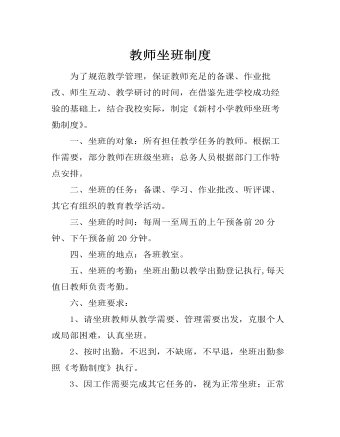
教师坐班制度
二、坐班的任务:备课、学习、作业批改、听评课、其它有组织的教育教学活动。 三、坐班的时间:每周一至周五的上午预备前20分钟、下午预备前20分钟。 四、坐班的地点:各班教室。 五、坐班的考勤:坐班出勤以教学出勤登记执行,每天值日教师负责考勤。 六、坐班要求: 1、请坐班教师从教学需要、管理需要出发,克服个人或局部困难,认真坐班。
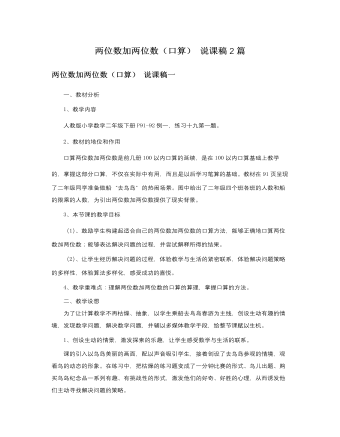
人教版新课标小学数学二年级下册两位数加两位数(口算)说课稿2篇
(四)、课堂总结、体验成功引导学生对所学知识、学习方法、学习结果、情感等进行全面总结,让学生体验学习的成功感,同时,进一步系统、完善知识结构。总之,本课的教学设计力求体现“以学生为本”的教学理念,具体体现在以下几个方面:(一)、创设生动的情景,激发探索的乐趣,让学生感受数学与生活的联系。课的引入以一幅学生经常接触的,喜闻乐见的购买玩具这一题材为切入点。在练习设计中,改变枯燥抽象的数字计算练习,选取了一组寓有童趣的素材。它们以丰富多彩的呈现方式深深地吸引着学生,使他们认识到现实生活中蕴含着大量的数学信息,使学生感到有趣、有挑战性,激发他们好奇,好胜的心理,从而诱发他们去主动寻求解决问题的策略,同时体验到数学与生活的联系。
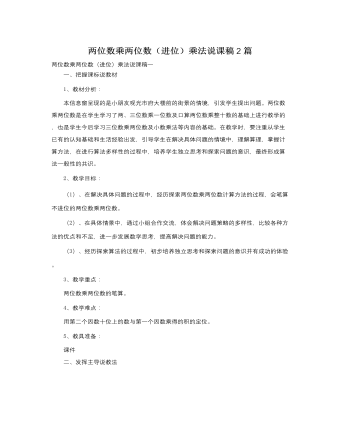
人教版新课标小学数学三年级下册两位数乘两位数(进位)乘法说课稿2篇
(一)创设情境,提出问题:学生的学习动机和求知欲不会自然涌现,它取决于教师所创设的学习情境,而兴趣是最好的老师,因此,在课的一开始,我设计了“今天我们再去街心公园看一看”这一情境:出示情境图:你看到了什么信息,你能提出什么数学问题?(板书)学生提出很多问题。设计意图:数学来源于生活,有趣的生活情境,激发学生好奇心和强烈的求知欲,让学生在生动具体的情境中学习数学,从而使教材与学生之间建立相互包容、相互激发的关系。让学生既认识了自身,又大胆而自然地提出猜想。(二)、探索新知解决问题“教师为主导,学生为主体,探究为主线”的三为主原则“保护环境”花坛一共用了多少盆花?怎样列式?
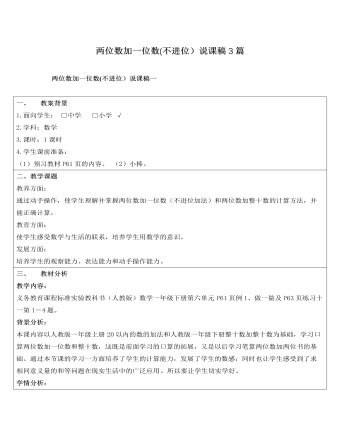
人教版新课标小学数学一年级下册两位数加一位数(不进位)说课稿3篇
一、说教材《两位数加一位数的进位加法》是人教版义务教育课程标准实验教科书一年级下册P62“两位数加一位数的进位加法”,本课是在两位数加一位数和整十数的基础上进行教学的。在本节课中,通过生活情境图,引入两位数加一位数的进位加法,并使学生在解决实际问题的过程中,进一步体会加法的意义,鼓励学生提出问题并解决问题,要让学生在独立思考的基础上,经历与他人交流的过程,探索并掌握两位数加一位数进位加法的计算方法,并能正确地计算,加强动手操作,探索计算方法,体会算法的多样性。根据本节课在教材中的地位和作用,依据小学数学课程标准和孩子们已有的认知水平,我把本节课的教学目标定为:1、知识与技能在解决实际问题的过程中,进一步体会加法的意义,探索并掌握两位数加一位数进位加法的计算方法。
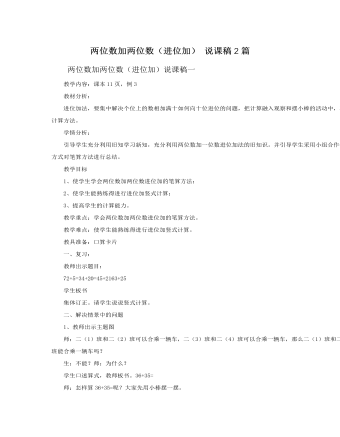
人教版新课标小学数学二年级上册两位数加两位数(进位加) 说课稿2篇
一、说教材:本课时主要的内容就是让学生在情境中掌握两位数加两位数的进位加法计算,让学生通过尝试和探索出多种算法,体验多种算法,然后比较出最好的算法。教学目标:1、通过具体的情境使学生更一步的理解加法的意义和提高学生的估算意识。2、通过学生的合作学习从而能探讨出多种计算两位数减两位退位减法的方法。3、培养学生的数学口语表达能力,提高学生的学习兴趣。4、掌握两位数加两位数(进位加)竖式的写法。重点:(1)通过学生的合作学习从而能探讨出多种计算两位数减两位退位减法的方法。(2)掌握笔算加法的计算法则。难点:对多样化算法进行优化,达到正确完成计算。发展学生的估算意识、和探究意识和解决实际问题的能力。二、说教法:组织学生在前面计算的基础上,自主探索出两位数加两位(进位加)的计算方法,并通过交流、讨论,达到对算法的优化,在通过“试一试”、“算一算”、“想一想”等形式达到知识的掌握。
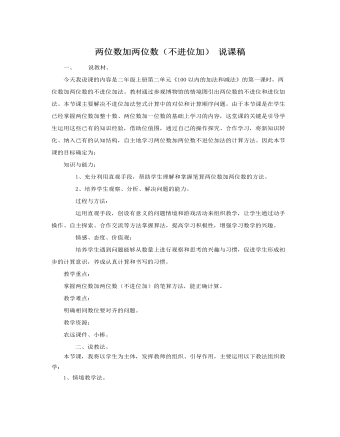
人教版新课标小学数学二年级上册两位数加两位数(不进位加) 说课稿
今天我说课的内容是二年级上册第二单元《100以内的加法和减法》的第一课时,两位数加两位数的不进位加法。教材通过参观博物馆的情境图引出两位数的不进位和进位加法。本节课主要解决不进位加法竖式计算中的对位和计算顺序问题。由于本节课是在学生已经掌握两位数加整十数、两位数加一位数的基础上学习的内容,这堂课的关键是引导学生运用这些已有的知识经验,借助位值图,通过自己的操作探究、合作学习,将新知识转化、纳入已有的认知结构,自主地学习两位数加两位数不进位加法的计算方法。因此本节课的目标确定为:知识与能力:1、充分利用直观手段,帮助学生理解和掌握笔算两位数加两位数的方法。2、培养学生观察、分析、解决问题的能力。过程与方法:运用直观手段,创设有意义的问题情境和游戏活动来组织教学,让学生通过动手操作、自主探索、合作交流等方法掌握算法,提高学习积极性,增强学习数学的兴趣。
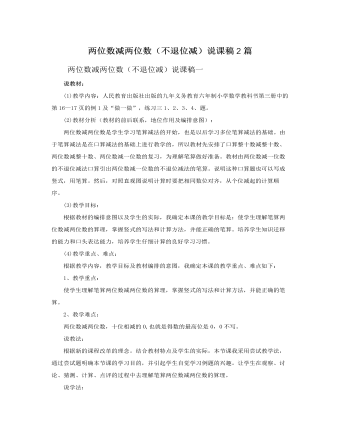
人教版新课标小学数学二年级上册两位数减两位数(不退位减)说课稿2篇
说教材:(1)教学内容:人民教育出版社出版的九年义务教育六年制小学数学教科书第三册中的第16—17页的例1及“做一做”,练习三1、2、3、4、题。(2)教材分析(教材的前后联系,地位作用及编排意图):两位数减两位数是学生学习笔算减法的开始,也是以后学习多位笔算减法的基础。由于笔算减法是在口算减法的基础上进行教学的,所以教材先安排了口算整十数减整十数、两位数减整十数、两位数减一位数的复习,为理解笔算做好准备。教材由两位数减一位数的不退位减法口算引出两位数减一位数的不退位减法的笔算。说明这种口算题也可以写成竖式,用笔算。然后,对照直观图说明计算时要把相同数位对齐,从个位减起的计算顺序。(3)教学目标:根据教材的编排意图以及学生的实际,我确定本课的教学目标是:使学生理解笔算两位数减两位数的算理,掌握竖式的写法和计算方法,并能正确的笔算。培养学生知识迁移的能力和口头表达能力,培养学生仔细计算的良好学习习惯。
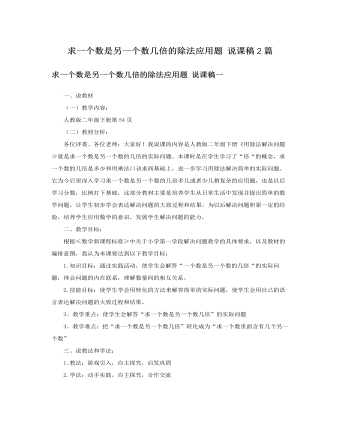
人教版新课标小学数学二年级下册求一个数是另一个数几倍的除法应用题说课稿2篇
一、说教材表内除法二单元主要内容有:7.8.9的乘法口诀求商,解决用除法计算的简单的实际问题,综合应用乘,除法计算的稍复杂的实际问题。本单元的目标是着重让学生在熟练掌握用口诀求商一般方法的基础上,综合应用表内乘除法的计算技能解决一些简单和稍复杂的涉及乘,除运算的实际问题。今天所教学的内容是解决问题中的第一个内容,求一个数是另一个数的几倍是多少,这课时的主要目标是:1、联系实际问题理解"一个数是另一个数的几倍"的含义,体会数量之间的相互关系;会用自己的语言表达解决问题的大致过程和结果。2、根据"倍"的概念和除法的含义,分析、推理、探究"求一个数是另一个数的几倍"的实际问题的一般方法;经历将"求一个数是另一个数的几倍是多少"的实际问题转化成"求一个数里面有几个另一个数"的数学问题的过程,初步学会用转化的方法来解决简单的实际问题。
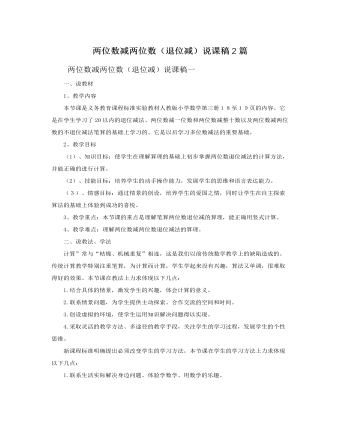
人教版新课标小学数学二年级上册两位数减两位数(退位减)说课稿2篇
一、说教材1、教学内容本节课是义务教育课程标准实验教材人教版小学数学第三册18至19页的内容。它是在学生学习了20以内的退位减法、两位数减一位数和两位数减整十数以及两位数减两位数的不退位减法笔算的基础上学习的。它是以后学习多位数减法的重要基础。2、教学目标(1)、知识目标:使学生在理解算理的基础上初步掌握两位数退位减法的计算方法,并能正确的进行计算。(2)、技能目标:培养学生的动手操作能力,发展学生的思维和语言表达能力。(3)、情感目标:通过情景的创设,培养学生的爱国之情,同时让学生在自主探索算法的基础上体验到成功的喜悦。3、教学重点:本节课的重点是理解笔算两位数退位减的算理,能正确用竖式计算。4、教学难点:理解两位数减两位数退位减法的算理。
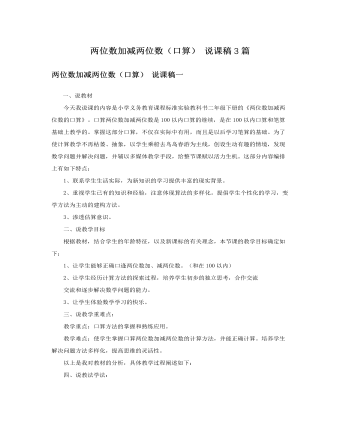
人教版新课标小学数学二年级下册两位数加减两位数(口算)说课稿3篇
二、说教学目标1、结合具体情境进一步理解加减法的意义,能正确口算得数是百以内数的两位数加减法。2、能利用所学知识,在教师的指导下提出并解决简单的实际问题,了解同一问题可以用不同的方法解决。3、经历与他人交流各自计算方法的过程,体验解决问题策略的多样性,感受学数学、用数学的乐趣。三、说教法、学法教法:为了使学生掌握好百以内的两位数加减两位数的口算这部分知识,达到以上教学目的,突破以上教学重难点,我采用了迁移法、引导法、讲解法、联系法、自主探索法来进行教学。学法:通过本课的学习,使学生学会利用旧知构建新知的方法、合作探究的方法,调动学生主动探索的积极性。四、说教学过程(一)创设情景、导入新课1、谈话:同学们,大千世界无奇不有。我们所处的人类的社会是由一个个担任不同工作的人所组成的,而和我们生活密切相关的蜜蜂也跟人类一样,它们生活在一个蜜蜂王国里,今天我们就一起到那里了解一下蜜蜂的生活吧。

